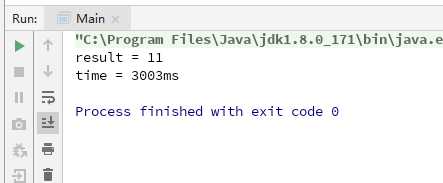一.Callable与Runnable
先说一下java.lang.Runnable吧,它是一个接口,在它里面只声明了一个run()方法:
|
1
2
3
|
public interface Runnable { public abstract void run();} |
由于run()方法返回值为void类型,所以在执行完任务之后无法返回任何结果。
Callable位于java.util.concurrent包下,它也是一个接口,在它里面也只声明了一个方法,只不过这个方法叫做call():
|
1
2
3
4
5
6
7
8
9
|
public interface Callable<V> { /** * Computes a result, or throws an exception if unable to do so. * * @return computed result * @throws Exception if unable to compute a result */ V call() throws Exception;} |
可以看到,这是一个泛型接口,call()函数返回的类型就是传递进来的V类型。
那么怎么使用Callable呢?一般情况下是配合ExecutorService来使用的,在ExecutorService接口中声明了若干个submit方法的重载版本:
|
1
2
3
|
<T> Future<T> submit(Callable<T> task);<T> Future<T> submit(Runnable task, T result);Future<?> submit(Runnable task); |
第一个submit方法里面的参数类型就是Callable。
暂时只需要知道Callable一般是和ExecutorService配合来使用的,具体的使用方法讲在后面讲述。
一般情况下我们使用第一个submit方法和第三个submit方法,第二个submit方法很少使用。
二.Future
Future就是对于具体的Runnable或者Callable任务的执行结果进行取消、查询是否完成、获取结果。必要时可以通过get方法获取执行结果,该方法会阻塞直到任务返回结果。
Future类位于java.util.concurrent包下,它是一个接口:
|
1
2
3
4
5
6
7
8
|
public interface Future<V> { boolean cancel(boolean mayInterruptIfRunning); boolean isCancelled(); boolean isDone(); V get() throws InterruptedException, ExecutionException; V get(long timeout, TimeUnit unit) throws InterruptedException, ExecutionException, TimeoutException;} |
在Future接口中声明了5个方法,下面依次解释每个方法的作用:
- cancel方法用来取消任务,如果取消任务成功则返回true,如果取消任务失败则返回false。参数mayInterruptIfRunning表示是否允许取消正在执行却没有执行完毕的任务,如果设置true,则表示可以取消正在执行过程中的任务。如果任务已经完成,则无论mayInterruptIfRunning为true还是false,此方法肯定返回false,即如果取消已经完成的任务会返回false;如果任务正在执行,若mayInterruptIfRunning设置为true,则返回true,若mayInterruptIfRunning设置为false,则返回false;如果任务还没有执行,则无论mayInterruptIfRunning为true还是false,肯定返回true。
- isCancelled方法表示任务是否被取消成功,如果在任务正常完成前被取消成功,则返回 true。
- isDone方法表示任务是否已经完成,若任务完成,则返回true;
- get()方法用来获取执行结果,这个方法会产生阻塞,会一直等到任务执行完毕才返回;
- get(long timeout, TimeUnit unit)用来获取执行结果,如果在指定时间内,还没获取到结果,就直接返回null。
也就是说Future提供了三种功能:
1)判断任务是否完成;
2)能够中断任务;
3)能够获取任务执行结果。
因为Future只是一个接口,所以是无法直接用来创建对象使用的,因此就有了下面的FutureTask。
三.FutureTask
我们先来看一下FutureTask的实现:
|
1
|
public class FutureTask<V> implements RunnableFuture<V> |
FutureTask类实现了RunnableFuture接口,我们看一下RunnableFuture接口的实现:
|
1
2
3
|
public interface RunnableFuture<V> extends Runnable, Future<V> { void run();} |
可以看出RunnableFuture继承了Runnable接口和Future接口,而FutureTask实现了RunnableFuture接口。所以它既可以作为Runnable被线程执行,又可以作为Future得到Callable的返回值。
FutureTask提供了2个构造器:
|
1
2
3
4
|
public FutureTask(Callable<V> callable) {}public FutureTask(Runnable runnable, V result) {} |
事实上,FutureTask是Future接口的一个唯一实现类。
四.使用示例
1.使用Callable+Future获取执行结果
|
1
2
3
4
5
6
7
8
9
10
11
12
13
14
15
16
17
18
19
20
21
22
23
24
25
26
27
28
29
30
31
32
33
34
35
36
37
|
public class Test { public static void main(String[] args) { ExecutorService executor = Executors.newCachedThreadPool(); Task task = new Task(); Future<Integer> result = executor.submit(task); executor.shutdown(); try { Thread.sleep(1000); } catch (InterruptedException e1) { e1.printStackTrace(); } System.out.println("主线程在执行任务"); try { System.out.println("task运行结果"+result.get()); } catch (InterruptedException e) { e.printStackTrace(); } catch (ExecutionException e) { e.printStackTrace(); } System.out.println("所有任务执行完毕"); }}class Task implements Callable<Integer>{ @Override public Integer call() throws Exception { System.out.println("子线程在进行计算"); Thread.sleep(3000); int sum = 0; for(int i=0;i<100;i++) sum += i; return sum; }} |
执行结果:

子线程在进行计算 主线程在执行任务 task运行结果4950 所有任务执行完毕
2.使用Callable+FutureTask获取执行结果
|
1
2
3
4
5
6
7
8
9
10
11
12
13
14
15
16
17
18
19
20
21
22
23
24
25
26
27
28
29
30
31
32
33
34
35
36
37
38
39
40
41
42
43
44
45
|
public class Test { public static void main(String[] args) { //第一种方式 ExecutorService executor = Executors.newCachedThreadPool(); Task task = new Task(); FutureTask<Integer> futureTask = new FutureTask<Integer>(task); executor.submit(futureTask); executor.shutdown(); //第二种方式,注意这种方式和第一种方式效果是类似的,只不过一个使用的是ExecutorService,一个使用的是Thread /*Task task = new Task(); FutureTask<Integer> futureTask = new FutureTask<Integer>(task); Thread thread = new Thread(futureTask); thread.start();*/ try { Thread.sleep(1000); } catch (InterruptedException e1) { e1.printStackTrace(); } System.out.println("主线程在执行任务"); try { System.out.println("task运行结果"+futureTask.get()); } catch (InterruptedException e) { e.printStackTrace(); } catch (ExecutionException e) { e.printStackTrace(); } System.out.println("所有任务执行完毕"); }}class Task implements Callable<Integer>{ @Override public Integer call() throws Exception { System.out.println("子线程在进行计算"); Thread.sleep(3000); int sum = 0; for(int i=0;i<100;i++) sum += i; return sum; }} |
如果为了可取消性而使用 Future 但又不提供可用的结果,则可以声明 Future<?> 形式类型、并返回 null 作为底层任务的结果。
标签:stat 服务 ace BMI 函数返回 简单 cut 完成 核心
原文地址:https://www.cnblogs.com/guofx/p/11179099.html

